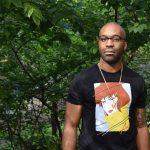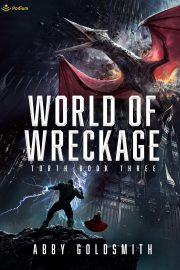Fine Weather, Isn’t It?
by Tochi Onyebuchi
(This article originally appeared in The SFWA Bulletin #215.)
What about the serial killers? What about the rapists? asks the skeptic in the face of the prison abolitionist. What about the violent crime and the predators? The real Bad People. You would just let them roam the streets? The questions are rarely genuine. The asker is prepared only to accept an inarticulate “yes” as an answer, proving the madness of the idea. What the abolitionist might posit instead, then, is: What are police for? Their presence, their ubiquity in some circumstances, fails to prevent serial killing and deter sexual assault. In fact, in typical if-you-build-it-they-will-come fashion, the institution that seems to need police the most is prison, because how else to fill all those cells?
A number of presumptions hold up the line of thinking that asserts the necessity of police and prisons: namely that the people the police target, the ones who wind up in jail or prison, deserve it; that the rest of us are left safer for it; and that “justice” is an inherently bloodthirsty conceit. Peace can only come after order has been restored, presuming some primordial rending. And the blood spilled in service of this mandate is not simply the cost of doing business but part and parcel of the whole deal. If others see how horribly the targeted and the incarcerated are treated, then they’ll fall in line. The more we bomb their homes, the more we topple their leaders, the more we raid their libraries and their homes, the more we make them fear a sky populated with Predator drones, the fewer terrorists there will be.
A titanically American way of thinking.
A poverty of imagination afflicts media-makers with regards to policing. As of April 23, 2020, 1,172 episodes of the Law & Order franchise have been beamed into homes across America. The franchise also includes five video games for PC. By the time it was taken off the air in June of 2020, Cops—that cinema vérité endorsement of police brutality and perhaps the most piquant example of police-media collusion—had run for thirty-two seasons, and was one of the longest-running programs in the United States. It clocked in, by the time of its demise, at 1,103 episodes.
It was thought, once upon a time, that the inversion of the good cop with the injection of and focus on the bad cop might complicate the picture some. There’s Hill Street Blues, which is a bit John the Baptist to NYPD Blue’s Messiah. Cops as protagonists and, it’s assumed, heroes. The latter show has won as many Primetime Emmys for Outstanding Drama as Mad Men and Game of Thrones, the record sitting tidily at four.
If the police are ever fallible, it’s to make way for more unconventional, more effective policing. Batman is a cop. He is pathologically wealthy, irredeemably violent, and plagued by the kind of undiagnosed psychosis that causes a billionaire to dress up as a chiroptera and oppress a decontextualized criminal society. The TV successor to the animated series, Batman Beyond, uncritically continues the trope. Spider-Man manages the feat of out-policing the police with a dash of community charm. What about the real Bad Guys? the skeptic asks. You would just let them roam the streets?
No, Spider-Man would handle it, of course.
Chris Redfield, Leon Kennedy, and Jill Valentine, protagonists of the first Resident Evil video games, are all cops. The enemies you shoot to kill are faceless in a different sense. The metaphor of a toxic environment filled with mindless, unreasonable, and grotesque Others is made flesh.
Police are agents of the State imbued with the authority to monopolize violence in service of the State. Break down the word “enforce” into its constituent parts and its greater half is violence. And it’s this mandate of public order that has expanded the idea of police beyond the position’s actual function. After the defeat of the Confederacy, localities throughout the South deputized thousands of Confederate veterans. The white South looked at freed Black Americans, no longer their property, and saw disorder, and so the police became instruments of restitution for the treasonous and the vanquished. Draft and pass a raft of legislation designating new property crimes—easy things to charge a freed Black American with, easy things to incarcerate them for—and a former plantation owner can be reunited with their property. The Ku Klux Klan are often called a “militia” and even domestic terrorists, but they were, in sense if not in color, police. The Bad Cops. According to FBI investigations, white supremacy has infiltrated law enforcement agencies across the country. Pair that with an intelligence operation launched by the Union Army to disrupt a Klan cell operating in Reconstruction South Carolina, and you find yourself standing between two mirrors, racialized violence refracted both ways into infinity.
Travel across America and note the police’s presence and absence, notice upon which corners they set up their posts, down which streets their cruisers amble. Notice which schools they occupy and which they don’t. Note how many officers can be found per square mile in Bridgeport, CT, and how many can be found in neighboring Fairfield. Then note the per capita income in the zip codes captured by each city. There’s a corralling going on, a slow-moving version of a “kettle” where riot police close off avenues and exits to a section of protesters, hemming them in as the countdown to curfew begins, so that when the clock strikes, they can beat and arrest to their heart’s content.
The police protect people, says the skeptic.
No, they protect property, replies the abolitionist.
*
The capitalistic imperative extends to prisons. Some of the most powerful opponents to efforts at decarceration are prison guard unions seeking to preserve economic security, private prison contractors seeking to house as many as possible with as little cost as possible, and the lawmakers (particularly during an election year) who gleefully accept their campaign contributions. For the majority public, incarceration’s out-of-sight-out-of-mind-ness entails removal of problem populations not just from the physical realm but from imagination altogether. If a buck can be made out of the enterprise, so much the better.
North of the Mason-Dixon, in America toward the end of the nineteenth century, the rise of incarceration came about in symbiosis with an increasingly administrative state. For upper and middle classes (and gradients between), the messiness of communal executions could be avoided. By sweeping it all behind the curtain of federal and state custodial authority, those with property could enjoy a less animalistic world and feel less animalistic by proxy. Its twin, the Southern tradition of incarceration that came about, had one organizing principle: subjugation. If you desire proof that the South did indeed win the War, look at how incarceration has morphed into revenge against the expansion of the political franchise in the United States. Chain gangs after Emancipation, the War on Drugs after the Civil Rights victories of the 1960s, the curtailing of voting rights for the incarcerated.
In North Carolina, in 1874, 384 of the state’s 455 prisoners were Black. In 1878, 846 of the state’s 952 prisoners were Black. In 1871 Virginia, 609 of the state’s 828 convicts were Black. Of the 67 female prisoners included in that total, 63 were Black. The courts met so rarely in the post-war years that prisoners would occupy prison cells for months at the government’s expense. The notion of employing them as labor sidestepped the issue of judicial efficiency and addressed the region’s economic deficit. Punishment morphed from a heavy public expense to a public revenue-generating enterprise. The postbellum South needed rebuilding. Consideration of the economic potential of convict labor continued into the twentieth century and continues even now. Perhaps one of the more unexpected consequences of today’s COVID-19 epidemic is that prison lockdowns throughout California are depleting the state of its crews of inmate firefighters.
The logic of prisons can even invade the realm of social justice, arguing for its necessity even as people call for their dismantling. You can hear it every time someone demands that the police officers who killed Breonna Taylor be arrested.
*
What does storytelling set in a non-carceral, anti-police story-world look like?
In speculative fiction, police may not be called police, but they are often defined as such. As off-screen as the State or its analog might be, its agents exist and provide order to the world of the narrative, if only to present boundaries for the hero’s quest to break through. Perhaps a more concrete version of the question is: What happens to the Bad People? Follow the thread, and you may find yourself asking who are the Bad People? Plunge deeper into the waters, and you’re forced to confront the question of “what is a Bad Person?”
Rethinking the carceral state in our fictions is an opportunity to completely reframe the relation between the individual and their environment. The demand isn’t for the eradication of conflict; conflict exists both as a narrative imperative (in the Western tradition) and as a thermodynamic principle. But how necessary is it as a story-world’s vertebrae?
Prison, police, rule-breaking, conflict, these things have so pervaded cultural consciousness that one could be forgiven for thinking that the entirety of human relation was nothing more than omnipresent criminality. Post-apocalyptic fiction is often presented as the landscape upon which the worst consequences of prison and police abolition rampage. Chaos, wanton violence, perpetual danger. But what if the true post-apocalypse is the 8.5 ft by 10 ft cell in which you’re forced to spend twenty-three hours a day, because you lacked the requisite amount of deference when responding to a corrections officer? There is more to human experience than the making and breaking of rules, and there is more to the world than the protection and violation of property.
Storytelling in a non-carceral, anti-police story-world assumes these truths. If the people of Gotham had greater access to affordable housing, if schools weren’t beholden to the vagaries of a district’s property taxes, if money were reallocated for mental health treatment, if there were no food deserts, and if there were enough opportunities for gainful employment, well, then maybe there would be less crime in Gotham, which might mean less police. Should the Mayor claim abolishing the police force in order to pay for these things would still result in a budget deficit, Bruce Wayne could sweep in and magnanimously cover the tab, doing more for Gotham in a single legislative cycle than he has done since his first appearance in 1939. But sometimes a traumatized, privileged white man simply wants to slam a villain’s face through a plate glass window, and whose story is more important than his?
*
Mono no aware has sometimes been translated from the Japanese as “the pathos of things” or the “‘ahh-ness’ of things,” meant to convey a deep emotional sensitivity to the transience of reality. It reminds me of what one writer early in my writing life called sensawunda, which could perhaps be looked at as the “‘whoa-ness’ of things.” Magic and cities falling from the sky and demigods walking among us. Talking about his short story titled “Mono no aware,” Ken Liu said he sought to redefine heroism along the lines of an “aesthetic primarily oriented towards creating in the reader an empathy towards the inevitable passing of all things.”
Earlier this year, I read Kazuo Ishiguro’s Never Let Me Go. I followed the children at that boarding school as they came up with stories to explain the odd world around them, followed them deeper into the story where the mystery of their purpose is slowly revealed, and followed the narrator to the book’s ending where she finds herself at a place where lost things, throughout the story, have been found. The narrator stands in a field of plowed earth and watches the wind carry rubbish into tree branches overhead.
I imagine the skeptic and the abolitionist stand beside her.
“Nice weather, isn’t it?” the abolitionist says.
The skeptic is convinced.
 Author bio: Tochi Onyebuchi is the author of the young adult novel Beasts Made of Night, which won the Ilube Nommo Award for Best Speculative Fiction Novel by an African, its sequel, Crown of Thunder, and War Girls, a Locus and Nommo Award Finalist. He holds degrees from Yale, the Tisch School of the Arts, Sciences Po, and Columbia Law School. Riot Baby is his adult fiction debut. (Photo Credit: Christina Orlando)
Author bio: Tochi Onyebuchi is the author of the young adult novel Beasts Made of Night, which won the Ilube Nommo Award for Best Speculative Fiction Novel by an African, its sequel, Crown of Thunder, and War Girls, a Locus and Nommo Award Finalist. He holds degrees from Yale, the Tisch School of the Arts, Sciences Po, and Columbia Law School. Riot Baby is his adult fiction debut. (Photo Credit: Christina Orlando)


